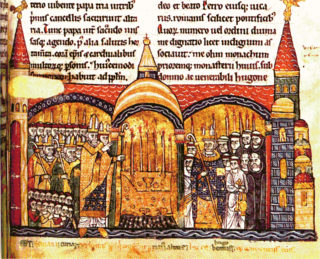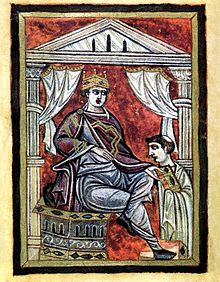
Adelaide of Italy, also called Adelaide of Burgundy, was Holy Roman Empress by marriage to Emperor Otto the Great. She was crowned with him by Pope John XII in Rome on 2 February 962. She was the first empress designated consors regni, denoting a "co-bearer of royalty" who shared power with her husband. She was essential as a model for future consorts regarding both status and political influence. She was regent of the Holy Roman Empire as the guardian of her grandson in 991–995.

The Ottonian dynasty was a Saxon dynasty of German monarchs (919–1024), named after three of its kings and Holy Roman Emperors named Otto, especially its first Emperor Otto I. It is also known as the Saxon dynasty after the family's origin in the German stem duchy of Saxony. The family itself is also sometimes known as the Liudolfings, after its earliest known member Count Liudolf and one of its most common given names. The Ottonian rulers were successors of the Germanic king Conrad I, who was the only Germanic king to rule in East Francia after the Carolingian dynasty and before this dynasty.

Theophanu was empress of the Holy Roman Empire by marriage to Emperor Otto II, and regent of the Empire during the minority of their son, Emperor Otto III, from 983 until her death in 991. She was the niece of the Byzantine Emperor John I Tzimiskes. She was known to be a forceful and capable ruler. Her status in the history of the Empire in many ways was exceptional. According to Wilson, "She became the only consort to receive the title 'co-empress', and it was envisaged she would succeed as sole ruler if Otto II died without a son."

Otto II, called the Red, was Holy Roman Emperor from 973 until his death in 983. A member of the Ottonian dynasty, Otto II was the youngest and sole surviving son of Otto the Great and Adelaide of Italy.

The Holy Roman Emperor, originally and officially the Emperor of the Romans during the Middle Ages, and also known as the Roman-German Emperor since the early modern period, was the ruler and head of state of the Holy Roman Empire. The title was held in conjunction with the title of king of Italy from the 8th to the 16th century, and, almost without interruption, with the title of king of Germany throughout the 12th to 18th centuries.

Aachen Cathedral is a Roman Catholic church in Aachen, Germany and the seat of the Roman Catholic Diocese of Aachen.

Louis V, also known as Louis the Do-Nothing, was a king of West Francia from 979 to his early death in 987. During his reign, the nobility essentially ruled the country. Dying childless, Louis V was the last Carolingian monarch in West Francia.

The Palatine Chapel in Aachen is an early medieval chapel and remaining component of Charlemagne's Palace of Aachen in what is now Germany. Although the palace itself no longer exists, the chapel was preserved and now forms the central part of Aachen Cathedral. It is Aachen's major landmark and a central monument of the Carolingian Renaissance. The chapel held the remains of Charlemagne. Later it was appropriated by the Ottonians and coronations were held there from 936 to 1531.

Lothair, sometimes called Lothair II, III or IV, was the penultimate Carolingian king of West Francia, reigning from 10 September 954 until his death in 986.

Pre-Romanesque art and architecture is the period in European art from either the emergence of the Merovingian kingdom in about 500 AD or from the Carolingian Renaissance in the late 8th century, to the beginning of the 11th century Romanesque period. The term is generally used in English only for architecture and monumental sculpture, but here all the arts of the period are briefly described.

Carolingian art comes from the Frankish Empire in the period of roughly 120 years from about 780 to 900—during the reign of Charlemagne and his immediate heirs—popularly known as the Carolingian Renaissance. The art was produced by and for the court circle and a group of important monasteries under Imperial patronage; survivals from outside this charmed circle show a considerable drop in quality of workmanship and sophistication of design. The art was produced in several centres in what are now France, Germany, Austria, northern Italy and the Low Countries, and received considerable influence, via continental mission centres, from the Insular art of the British Isles, as well as a number of Byzantine artists who appear to have been resident in Carolingian centres.

Ottonian art is a style in pre-romanesque German art, covering also some works from the Low Countries, northern Italy and eastern France. It was named by the art historian Hubert Janitschek after the Ottonian dynasty which ruled Germany and Northern Italy between 919 and 1024 under the kings Henry I, Otto I, Otto II, Otto III and Henry II. With Ottonian architecture, it is a key component of the Ottonian Renaissance. However, the style neither began nor ended to neatly coincide with the rule of the dynasty. It emerged some decades into their rule and persisted past the Ottonian emperors into the reigns of the early Salian dynasty, which lacks an artistic "style label" of its own. In the traditional scheme of art history, Ottonian art follows Carolingian art and precedes Romanesque art, though the transitions at both ends of the period are gradual rather than sudden. Like the former and unlike the latter, it was very largely a style restricted to a few of the small cities of the period, and important monasteries, as well as the court circles of the emperor and his leading vassals.

Ottonian architecture is an architectural style which evolved during the reign of Emperor Otto the Great. The style was found in Germany and lasted from the mid 10th century until the mid 11th century.

The Ottonian Renaissance was a renaissance of Byzantine and Late Antique art in Central and Southern Europe that accompanied the reigns of the first three Holy Roman Emperors of the Ottonian dynasty: Otto I (936–973), Otto II (973–983), and Otto III (983–1002), and which in large part depended upon their patronage. The leading figures in this movement were Pope Sylvester II and Abbo of Fleury.

The Gospels of Otto III is considered a superb example of Ottonian art because of the scope, planning, and execution of the work. The book has 276 parchment pages and has twelve canon tables, a double page portrait of Otto III, portraits of the four evangelists, and 29 full page miniatures illustrating scenes from the New Testament. The cover is the original, with a tenth-century carved Byzantine ivory inlay representing the Dormition of the Virgin. Produced at the monastery at Reichenau Abbey in about 1000 CE., the manuscript is an example of the highest quality work that was produced over 150 years at the monastery.

By the 10th century, Christianity had spread throughout much of Europe and Asia. The Church in England was becoming well established, with its scholarly monasteries, and the Roman Church and the Eastern Orthodox Church were continuing their separation, ultimately culminating in the Great Schism.

Henry II, also known as Saint Henry the Exuberant, Obl. S. B., was Holy Roman Emperor from 1014. He died without an heir in 1024, and was the last ruler of the Ottonian line. As Duke of Bavaria, appointed in 995, Henry became King of the Romans following the sudden death of his second cousin, Emperor Otto III in 1002, was made King of Italy in 1004, and crowned emperor by Pope Benedict VIII in 1014.

The Liuthar Gospels are a work of Ottonian illumination which are counted among the masterpieces of the period known as the Ottonian Renaissance. The manuscript, named after a monk called Liuthar, was probably created around the year 1000 at the order of Otto III at the Abbey of Reichenau and lends its name to the Liuthar Group of Reichenau illuminated manuscripts. The backgrounds of all the images are illuminated in gold leaf, a seminal innovation in western illumination.

The motto Renovatio regni Francorum was used by several monarchs of the Carolingian, Widonid and Ottonian dynasties in the 9th through 11th centuries. It served to emphasise the importance of the ethnic Franks and the Frankish tradition in the multinational empires of the Carolingians and Ottonians.

Otto III, Holy Roman Emperor, also called miribilia mundi, despite his short life, is a historical figure who attracts considerable scholarly attention as well as inspires numerous artistic and popular depictions.



















